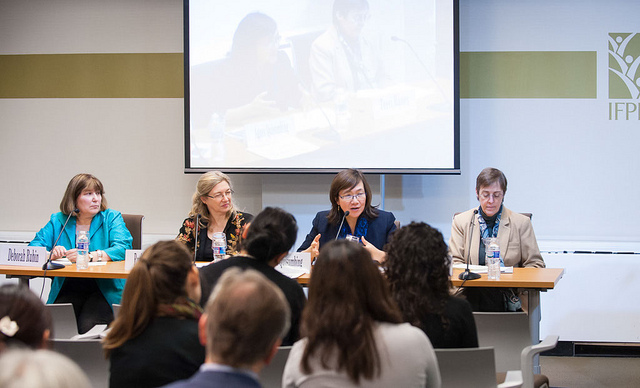Have you heard the statistic that while women account for 60 to 80 percent of global food production, they own only 2 percent of the world’s land? If you work in international development, you most likely have come across such “gender myths.” At a recent policy seminar, “Beyond Gender Myths: Closing the Knowledge Gap in Agriculture and Food Security,” speakers from IFPRI, the Food and Agriculture Organization of the United Nations (FAO), and Cultural Practice presented evidence from a book of studies to be published in 2014 and explained why this statistic and others like it are skewed—and potentially dangerous.
“The evidence available on women in agriculture was just so bad,” said Terri Raney, a senior economist at FAO and editor of the UN’s 2010–2011 State of Food and Agriculture (SOFA) report, which focused on women in agriculture. As Raney explained, the tables in the report’s appendix were full of knowledge gaps: “For every country in the world, we published the gender indicators that were available—the share of women in agriculture, the share of female-headed households, the percentage of land held by women—and you saw line after line of blanks. I think that sent a very subtle message calling for improvements.”
Several facts about women’s role in agriculture did emerge in the process, however. First, women operate smaller farms than men do; and second, these farms produce lower yields than those operated by men, largely attributed to the fact that women have access to fewer inputs and resources, ranging from fertilizer and tools to extension and credit. Researchers determined that increasing productivity within female-headed farms by 20 to 30 percent would raise national productivity by 2.5 to 4 percent in developing countries, which, in turn, could lift as many as 100 to 150 million people out of chronic hunger.
IFPRI Senior Researcher Agnes Quisumbing and collaborators conducted various gender-specific studies as part of the SOFA report, ultimately discrediting the 2 percent women’s land ownership myth. They found that the proportion of land controlled by women in Africa south of the Sahara is closer to 22 percent. The household surveys and plot-level studies allowed for a more nuanced understanding of ownership, which can involve joint ownership with male household members.
In addition to land ownership, researchers evaluated women’s productivity from the perspective of their access to social capital, specifically via group membership and participation in social networks. “Social capital is an entry point for so many development programs in agriculture and other sectors,” said IFPRI Senior Research Fellow Ruth Meinzen-Dick. Moreover, many decentralization programs aim to transfer control of natural resources to community groups, but if women are not eligible or able to participate in these groups, they have little or no say over how valuable resources like water and forests are managed.
In practice, the new data can benefit program planning, particularly within the structure of agricultural value chains, to better accommodate gender differences, according to Deborah Rubin, co-director of Cultural Practice. She explained, “When you decrease discrimination, you increase efficiency… By being intentional about the way that you define and design these value chains, you can achieve the two goals (of gender equality and economic growth).”







